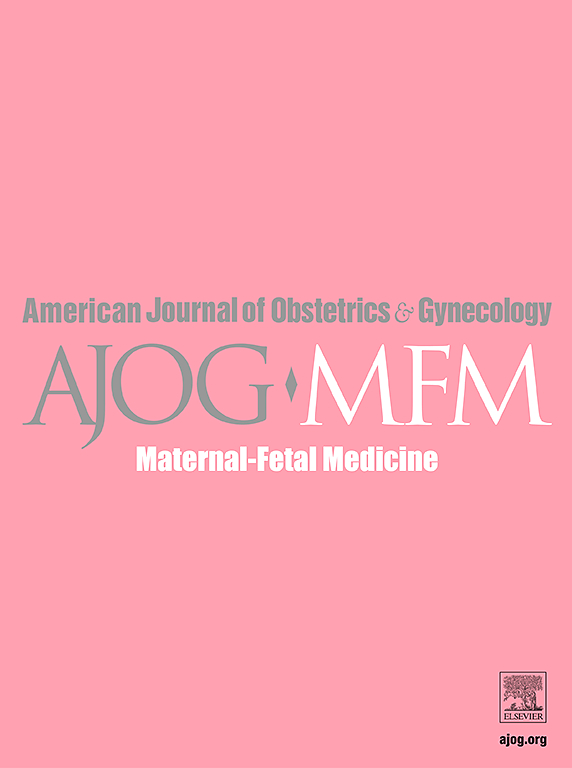Routine vaginal examination scheduled at 8 vs 4 hours in multiparous women in early spontaneous labor: a randomized controlled trial
IF 3.1
2区 医学
Q1 OBSTETRICS & GYNECOLOGY
American Journal of Obstetrics & Gynecology Mfm
Pub Date : 2025-08-18
DOI:10.1016/j.ajogmf.2025.101762
引用次数: 0
Abstract
BACKGROUND
Vaginal examination can cause pain and embarrassment, but it is recommended to be performed at least every 4 hours to monitor progress in labor. Trial data are sparse on its ideal frequency. Haste to diagnose labor dystocia, especially in low-risk multiparous women, and to resort to oxytocin augmentation and operative delivery may be counterproductive.
OBJECTIVE
This study aimed to evaluate scheduling the first follow-up vaginal examination at 8 vs 4 hours after diagnosis of early spontaneous labor (cervical dilatation of 3–5 cm) in multiparas.
STUDY DESIGN
A randomized controlled trial was conducted from October 2023 to October 2024 in a university hospital. Multiparas at term were recruited at diagnosis of early spontaneous labor. Participants were randomized to vaginal examination scheduled at 8 or 4 hours. Interim vaginal examination was permitted as clinically indicated. The 2 primary outcomes were the time to birth (noninferiority hypothesis) and maternal satisfaction assessed using a 0-to-10 numerical rating scale (superiority hypothesis). Data were analyzed using the t test, Mann–Whitney U test, chi-square test (or Fisher exact test), as appropriate.
RESULTS
A total of 254 women were randomized (127 to each arm). Participants’ characteristics across trial arms were similar. The interval from diagnosis of early labor to birth was mean±standard deviation 4.1±3.0 hours in the 8-hour arm vs 4.5±2.8 hours in the 4-hour arm (mean difference, −0.5; 95% confidence interval, −1.2 to 0.3 hours; P=.218), which was noninferior within the prespecified 2-hour margin. The score of maternal satisfaction with the allocated vaginal examination experience was significantly lower in the 8-hour arm (median [interquartile range], 8 [7–9] vs 9 [8–9]; P<.001) (11-point 0-to-10 numerical rating scale). The number of vaginal examinations from labor diagnosis to second stage was median (interquartile range) 1 (1–2) vs 1 (1–2) (P=.006; mean±standard deviation, 1.4±0.6 vs 1.6±0.8; mean difference, −0.2; 95% confidence interval, −0.1 to −0.4; P=.007), the oxytocin augmentation rates were 22.0% (28/127) vs 34.6% (44/127) (relative risk, 0.64; 95% confidence interval, 0.42–0.95; P=.026), the epidural analgesia rates were 7.1% (9/127) vs 15.0% (19/127) (relative risk, 0.47; 95% confidence interval, 0.22–1.00; P=.045), and the rates of recommendation of the allocated intervention to a friend were 83.5% (106/127) vs 100% (127/127) (P<.001) in the 8- and 4-hour arms, respectively. In the 8-hour arm, the first vaginal examination was more likely to be indicated by a bearing-down sensation or nonreassuring fetal heart rate tracing, and less likely to be performed as scheduled at 8 hours. The rates of cesarean delivery, maternal fever, perineal injury, and postpartum hemorrhage were not different. Neonatal outcomes, including Apgar scores, umbilical cord artery blood pH, base excess, and admission also did not differ significantly.
CONCLUSION
First vaginal examination scheduled at 8 hours compared with 4 hours was noninferior for the time interval to birth, but maternal satisfaction was significantly lower.
一项随机对照试验:多胎早期自然分娩妇女在8小时和4小时进行常规阴道检查。
背景:阴道检查可引起疼痛和尴尬,但建议至少每4小时检查一次,以监测分娩进展。试验数据在理想强度上是稀疏的。急于诊断难产,特别是在低风险的多胎妇女,并诉诸催产素增强和手术分娩可能适得其反。目的:探讨多产妇早期自然分娩(宫颈扩张3-5 cm)后8小时和4小时首次阴道随访检查的安排。材料与方法:于2023年10月至2024年10月在某大学附属医院进行随机对照试验。在诊断早期自然分娩时招募足月多胞胎。参与者在预定的8或4小时随机进行阴道检查。根据临床指示,允许进行阴道中期检查。两个主要结局是出生时间(非劣效假设)和母亲满意度(采用0-10数值评定量表[NRS])(优势假设)。数据分析采用t检验、Mann-Whitney U检验、卡方检验(或Fisher精确检验)。结果:254名女性被随机分组,每组127名。各试验组参与者的特征相似。早期产程至分娩间隔诊断的平均±标准差为4.1±3.0(8小时组)vs 4.5±2.8(4小时组),平均差异为-0.5 95% CI为-1.2至0.3小时p=0.218,在预定的2小时范围内不差,分配阴道检查经验的产妇满意度评分为中位数[四分位数范围]8[7-9]vs 9[8-9]。第一次阴道检查的时间间隔为8小时,分娩时间间隔为4小时,但产妇满意度明显较低。
本文章由计算机程序翻译,如有差异,请以英文原文为准。
求助全文
约1分钟内获得全文
求助全文
来源期刊

American Journal of Obstetrics & Gynecology Mfm
Medicine-Medicine (all)
CiteScore
7.40
自引率
3.20%
发文量
254
审稿时长
40 days
期刊介绍:
The American Journal of Obstetrics and Gynecology (AJOG) is a highly esteemed publication with two companion titles. One of these is the American Journal of Obstetrics and Gynecology Maternal-Fetal Medicine (AJOG MFM), which is dedicated to the latest research in the field of maternal-fetal medicine, specifically concerning high-risk pregnancies. The journal encompasses a wide range of topics, including:
Maternal Complications: It addresses significant studies that have the potential to change clinical practice regarding complications faced by pregnant women.
Fetal Complications: The journal covers prenatal diagnosis, ultrasound, and genetic issues related to the fetus, providing insights into the management and care of fetal health.
Prenatal Care: It discusses the best practices in prenatal care to ensure the health and well-being of both the mother and the unborn child.
Intrapartum Care: It provides guidance on the care provided during the childbirth process, which is critical for the safety of both mother and baby.
Postpartum Issues: The journal also tackles issues that arise after childbirth, focusing on the postpartum period and its implications for maternal health. AJOG MFM serves as a reliable forum for peer-reviewed research, with a preference for randomized trials and meta-analyses. The goal is to equip researchers and clinicians with the most current information and evidence-based strategies to effectively manage high-risk pregnancies and to provide the best possible care for mothers and their unborn children.
 求助内容:
求助内容: 应助结果提醒方式:
应助结果提醒方式:


